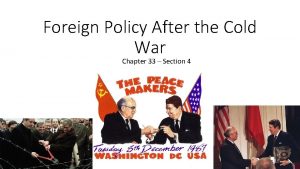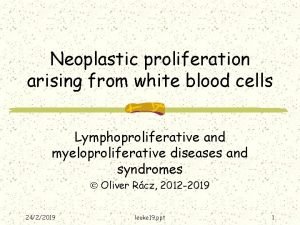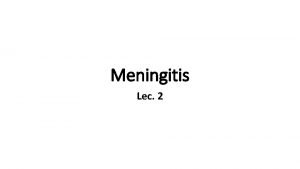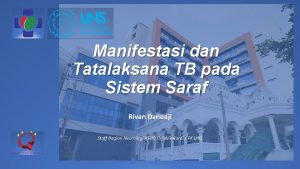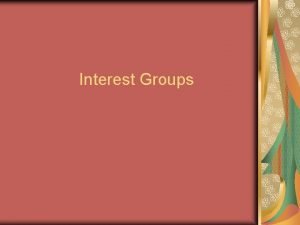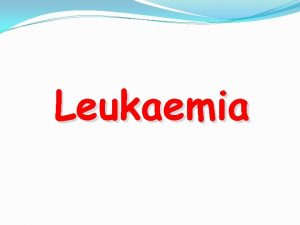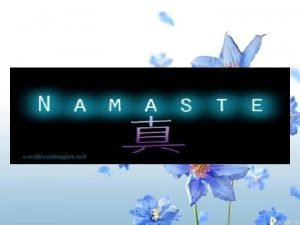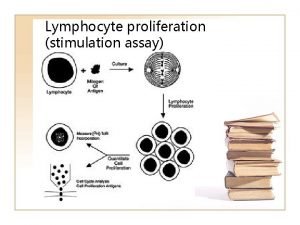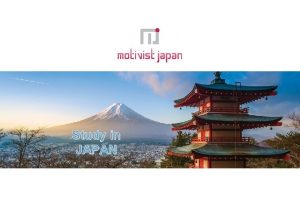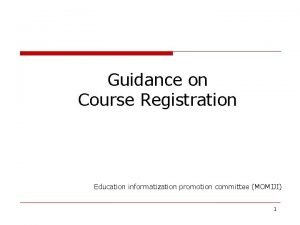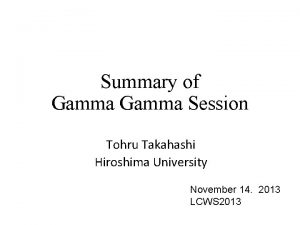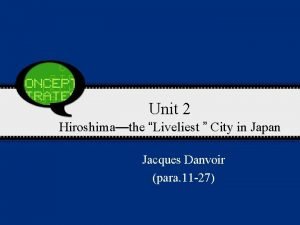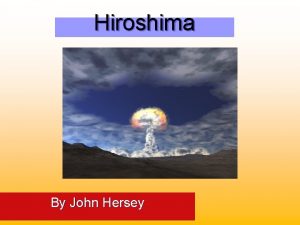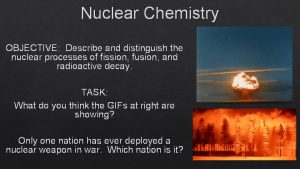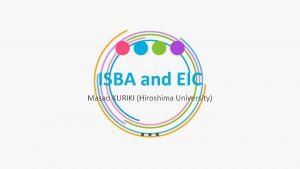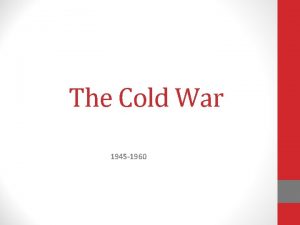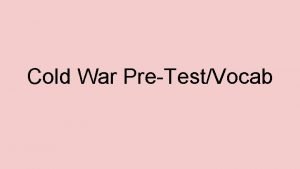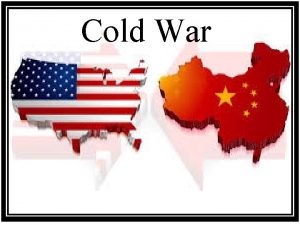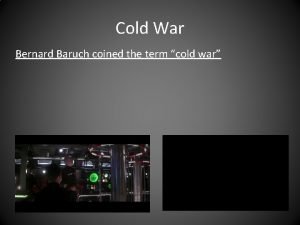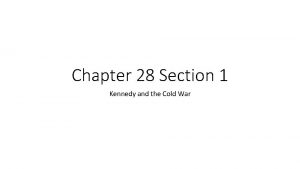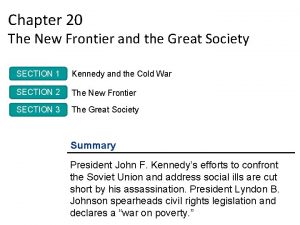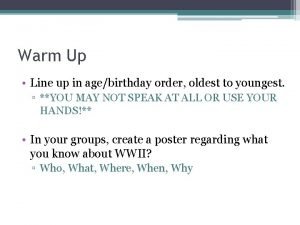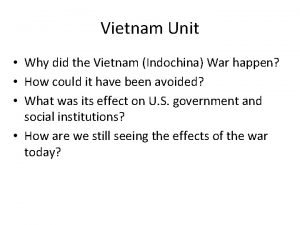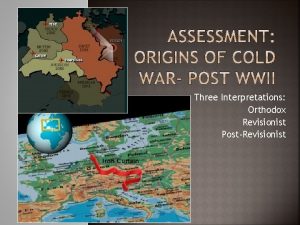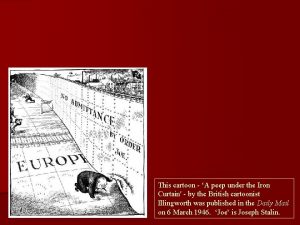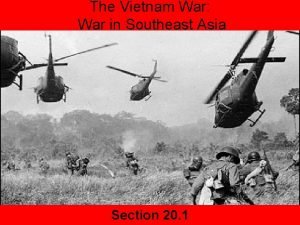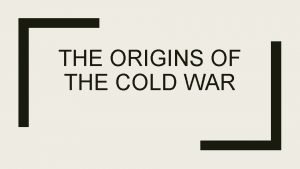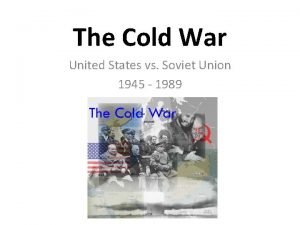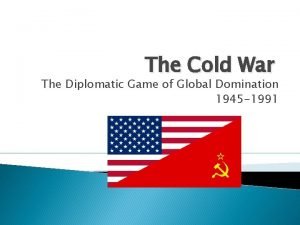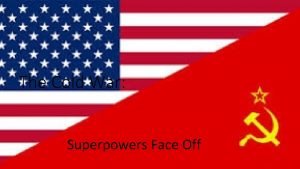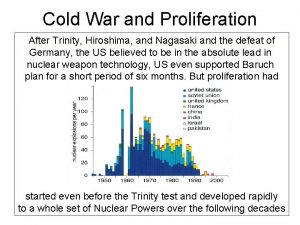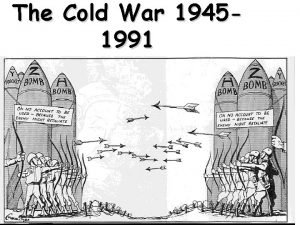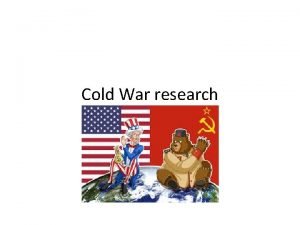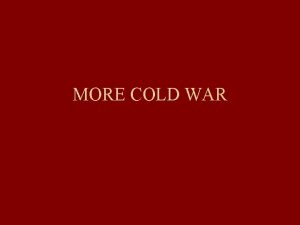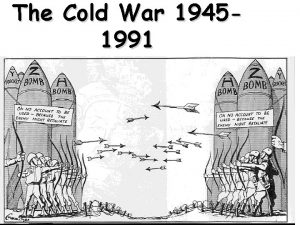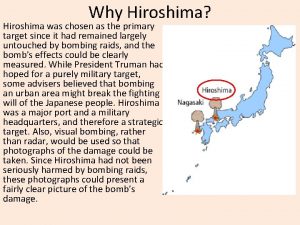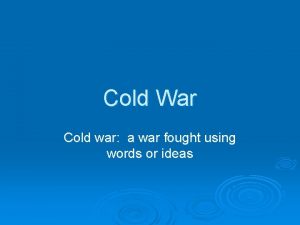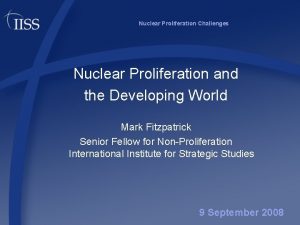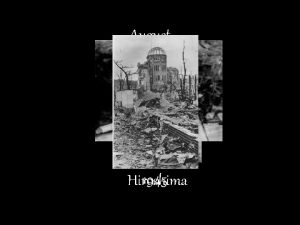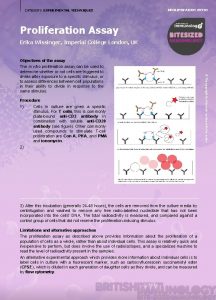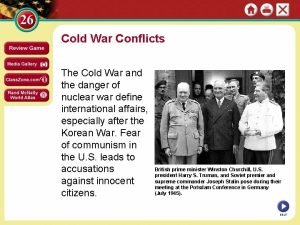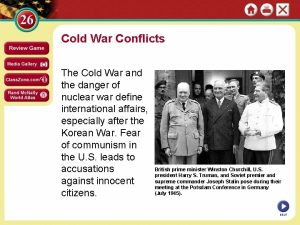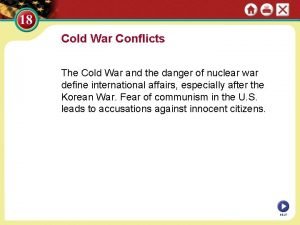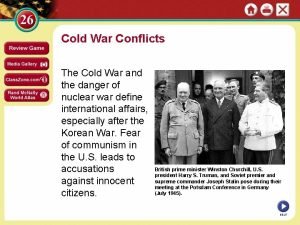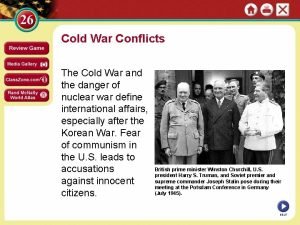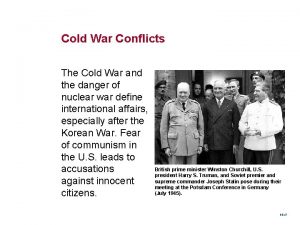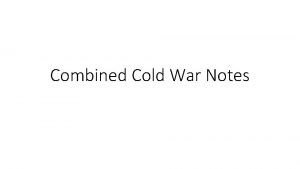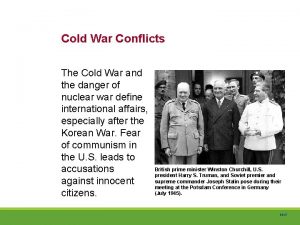Cold War and Proliferation After Trinity Hiroshima and







































- Slides: 39

Cold War and Proliferation After Trinity, Hiroshima, and Nagasaki and the defeat of Germany, the US believed to be in the absolute lead in nuclear weapon technology, US even supported Baruch plan for a short period of six months. But proliferation had started even before the Trinity test and developed rapidly to a whole set of Nuclear Powers over the following decades

Spies and Proliferation At Potsdam conference 1945 Stalin was informed about US bomb project. Efficient Russian spy system in US had been established based on US communist cells and emigrant sympathies and worries about single dominant political and military power. Klaus Fuchs, German born British physicist, part of the British Collaboration at the Manhattan project passed information about Manhattan project and bomb development and design Plans to Russia. Arrested in 1949 in Britain and convicted to 14 years of prison. He served 9 years - returned to East Germany as Director of the Rossendorf Nuclear Research center. Fuchs case cause panic and enhanced security in US in times of cold war, fired by Mc. Carthy propaganda. Numerous subsequent arrests and trials culminating in Rosenberg case!

The second race for the bomb

Start of soviet weapons program Program was ordered by Stalin in 1943 after being informed about US efforts. The administrative head of the program was Lavrenti Beria. Scientific director was Igor Kurchatov, Who headed the Russian nuclear research program and built the first Russian cyclotron in 1934. Lavrenty Pavlovich Beria (1899 -1953), Soviet politician and police chief, is remembered chiefly as the executor of Stalin’s Great Purge of the 1930 s His period of greatest power was during and after WW-II. After Stalin's death he was removed from office and executed by Stalin's successors.

Citizen Kurchatov (1903 -1960); head of the Soviet Nuclear physics program. He developed the first Russian Cyclotron 1934, built the first Russian reactor 1946, developed the first Russian fission Bomb 1949, and the first fusion bomb 1955. Named after him are the Kurchatov Institute and element 104 Kurchatovium. Kurchatov managed to build with full support of Stalin and Beria a competitive nuclear research program from 1943 to 1945, stimulated by successful Trinity test. He built entire weapons research laboratory structure called Arzamas-16, taking Manhattan project structure as a guide. Arzamas-16 was often referred to as Los Arzamas (since 1993 sister city of Los Alamos). Arzamas-16 represented a network of “secret cities” and research labs.

Arzamas-16 In 1946 little monastery town Sarov disappeared from Russian official maps. The town became the site for the first Russian nuclear weapons laboratory Presently home of two weapons facilities: The VNIEF nuclear weapon design institute AVANGARD warhead assembly facility

Secret Cities Arzamas-16: 29 km 2 about 82, 000 population, fenced off from surrounding area. Has been center for Soviet and Russian nuclear research for 50 years. Besides Arzamas-16 there existed nearly 50 additional nuclear weapon research, production and test sites distributed over area of former Soviet Union. Privileged workers and researchers under heavy KGB surveillance. The camps and facilities were all build by GULAG workers and POWs.

Success

First Lightening Joe-1 Plutonium based 22 KT bomb; the plutonium was generated at Cheliabinsk-40 breeder reactor built by Kurchatov in 1947 Yuli Khariton (1904 -1996) Leading Russian weapon designer, last living pupil of Rutherford The Soviet first bomb was called by the Americans "Joe 1", Joe-1 was an exact copy of “fat man” based on Intelligence from Klaus Fuchs and other US-based scientists. The copy approach was made on insistence of Beria to warrant quick success. The explosion at the Semipalatinsk test site in Kazakhstan was successful. First Lightening/Joe 1 August 29, 1949

New Sloyka design by Sakharov Layer Cake: alternate layers of light (liquid deuterium and tritium) & heavy (235 U) nuclear fuel to trigger a fission fusion reaction. In 1950 As “father” of the Soviet Hydrogen Bomb First design study by Andrei Sakharov 1989, as regime dissident

Sloyka-design, RDS-6 or Joe-4 August 12, 1953 At Semipalatinsk The RDS-6 s used a 235 U fissile core surrounded by alternating layers of fusion fuel (6 Li deuteride with tritium), and fusion tamper (natural uranium) inside a high explosive implosion system. The small 235 U fission bomb acted as the trigger (about 40 kt). The total yield was 400 Kt, and 15 -20% of the energy was released by fusion, and 90% due to the fission reaction. "The earth trembled beneath us, and our faces were struck, like the lash of a whip, by the dull, strong sound of the rolling explosion. From the jolt of the shock wave it was difficult to stand on one's feet. A cloud of dust rose to a height of eight kilometers. The top of the mushroom reached a height of twelve kilometers, while the diameter of the dust of the cloud column was approximately six kilometers. For those who observed the explosion from the west, day was replaced by night. "

The fusion process 2 H+3 H 4 He+n+Q ≡ 17. 6 Me. V Energy release Q=17. 6 Me. V In comparison 1 H+3 H +Q ≡ 4. 0 Me. V 2 H+2 H 3 He+n +Q ≡ 3. 2 Me. V 3 H+3 H 4 He+2 n+Q ≡ 11. 3 Me. V 235 U+n X +X +3 n +Q ≈ 200 Me. V A B 2 H+2 H Fusionable Material, deuterium 2 H (D) and tritium 3 H (t): Deuterium: natural occurrence (heavy water) (0. 015%). Tritium: natural occurrence in atmosphere through Cosmic ray bombardment; radioactive with T 1/2=12. 3 y.

“Advantages” of hydrogen bomb Fusion of 2 H+3 H: Fission of 235 U: Fusion is 4 times more powerful than fission and generates 24 times more neutrons! Neutron production:

Fuel considerations Successful operation of hydrogen bomb requires light fusionable fuel. q deuterium for d+d based bombs q tritium & deuterium for d+t based bombs q tritium needs to be replaced regularly q on-line produced tritium through 6 Li(n, t) Industrial production facilities are necessary.

Deuterium fuel production Deuterium separation takes place by electrolysis or chemical catalysts based Methods with subsequent distillation. Electrolysis separates water in oxygen and hydrogen. The hydrogen and deuterium mix can then be liquefied and distilled to separate the two species. Chemistry based methods include distillation of liquid hydrogen and various chemical exchange processes which exploit the differing affinities of deuterium and hydrogen for various compounds. These include the ammonia-hydrogen system, which uses potassium amide as the catalyst, and the hydrogen sulfidewater system (Girdler Sulfide process). Process enriches to ~15% deuterium. Distillation process of deuterium enriched water leads to 99% enrichment – boiling points of heavy water (101. 4 °C) and normal water (100 °C). Known producers are Argentina, Canada, India, Norway, plus all five declared Nuclear Powers. Recent newcomers are Pakistan and Iran.

Heavy Water Plants Newly-Identified Heavy Water Plant Khushab, Pakistan The estimated production capacity is 50 -100 tons of heavy water per year. Kota, India

Tritium fuel production Tritium occurs naturally but low abundance can be enhanced by accelerator or reactor based Tritium breeding through neutron capture on 6 Li(n, t)4 He. The United States has not produced tritium since 1988, when the Department of Energy Closed it’s production facility site in South Carolina closed. Immediate tritium needs are being met by recycling tritium from dismantled U. S. nuclear weapons. New plans?

Maintaining weapon stock-pile 0. 9 tritium filling (%) Loss of tritium fuel in nuclear warheads by natural decay ~5% per year! 1 0. 8 0. 7 0. 6 0. 5 0. 4 0. 3 0. 2 0. 1 0 10 20 30 time (y) To keep nuclear weapons stockpiles at the level prescribed by the START I (Strategic Arms Reduction Treaty), however, the United States will require a tritium supply capable of producing three kilograms of tritium each year, to go online no later than 2007.

New US tritium production plans On May 22, 1996, DOE and NRC agreed on the use of commercial reactors for the production of tritium. Lithium containing control rods instead of boron rods will be used in pressurized water reactors for absorbing neutrons. Neutron capture the lithium the control rods will produce tritium. The rods are later removed from the fuel assemblies for extracting the tritium. The two production reactors are Watts Bar Nuclear Plant and Sequoyah Nuclear Plant in Tennessee. Non-proliferation Concerns!

Disadvantages for hydrogen bomb Coulomb Penetrability 1. 0 E+00 1. 0 E-03 Prevents “thermal” Ignition! 2 H+3 H fusion probability 1. 0 E-06 1. 0 E-09 1. 0 E-12 1. 0 E-15 0. 001 High ignition temperature Required: 50 -100 Million K 0. 01 0. 1 1 10 Energy Acceleration of positive charged particles towards high energies above Coulomb barrier is necessary!

The Fathers of (US) Hydrogen Bomb All thermonuclear weapons existing in the world today appear to be based on a scheme usually called the "Teller-Ulam" design (after its inventors Stanislaw Ulan and Edward Teller, two emigrant s), or "staged radiation implosion" for a physically descriptive designation. Teller, Hungarian physicist, Ph. D 1930 Leipzig, Germany with Heisenberg. Emigration to the US 1935. He worked With Oppenheimer in 1943 -1946 on the Manhattan project. Stanislaw Ulan Ulam, Polish mathematician, came 1935 to US (Harvard), joined Manhattan project in 1943; Edward Teller

Ulam-Teller design Main idea by Ulam was to use shock compression for raising temperature. Teller complemented that idea by suggesting radiation driven shock Device is based on d+d & d+t reaction With on-line 6 Li(n, t) t-production and n Induced fission.

Lawrence Livermore Laboratory Founded in 1952 in San Francisco bay area as second US weapons National Laboratory for the development and construction of H bomb. H-bomb development and test program progressed through Livermore. First director Edward Teller, most controversial figure in nuclear weapons history Fight with Oppenheimer about H-bomb feasibility, accusing Oppenheimer disloyalty (Oppenheimer lost security clearance in 1954). Pushed weapons test program from the early 50 s to the 80 s, instigated Reagan’s star war program

Modern Thermonuclear Warhead The bomb design is based on a bomb casing containing implosion fission bomb and a cylinder casing of 238 U (tamper). Within the tamper is the 6 Li. D (fuel) and a hollow rod of 239 Pu in the center of the cylinder. Separating the cylinder from the implosion bomb is a shield of 238 U and plastic foam that fills the remaining space in the bomb casing.

Modern H-bomb design The detonation of the trigger bomb will cause the following sequence of events: 1. The fission bomb implodes, emitting X-rays. 2. X-rays heat the interior of the bomb and the tamper; which prevents premature detonation of the fuel. 3. The heat causes the tamper to expand burn away, exerting pressure inward against the lithium deuterate. The lithium deuterate is squeezed by about 30 -fold. 4. The compression shock waves initiates fission in the plutonium rod. 5. The fissioning rod gives off radiation, heat and neutrons. 6. The neutrons enter the lithium deuterate, and generate tritium. 7. The combination of high temperature and pressure is sufficient for tritium-deuterium and deuterium-deuterium fusion reactions to occur, producing more heat, radiation and neutrons. 8. The neutrons from the fusion reactions induced fission in the uranium-238 pieces from the tamper and shield. 9. Fission of the tamper and shield pieces produced even more radiation and heat. 10. The bomb explodes.

• First staged fusion explosion occurred on Eniwetok Atoll on Oct. 31, 1952. • Mike used liquid deuterium as a fuel. • The output of 10. 4 megatons of TNT exceeded all of the explosives used in WW II including both atomic bombs. Mike consisted of a cylinder about 20 ft high, ~7 ft wide, weighing 164, 000 lb; The detonation of Mike left underwater crater 6240 feet wide and 164 ft deep. Mike created a fireball 3 miles wide; the 'mushroom' cloud rose to 57, 000 ft in 90 seconds, and topped out in 5 minutes at 135, 000 ft , with a stem eight miles across. The cloud eventually spread to 1000 miles wide, with a stem 30 miles across. 80 million tons of soil were lifted into the air by the blast. "

Soviet Response 1955 RDS-37: The First Soviet Superbomb ("True H-Bomb") Test November 22, 1955; Semipalatinsk Test Site, Kazakhstan The bomb exploded underneath an inversion layer, which focused the shock back toward the ground unexpectedly. This refracted shock wave did unanticipated collateral damage, killing three people from a building collapse.


The cold war and nuclear arms race I remember President Kennedy once stated. . . that the United States had the nuclear missile capacity to wipe out the Soviet Union two times over, while the Soviet Union had enough atomic weapons to wipe out the Unites States only once. . . When journalists asked me to comment. . . I responded, "Yes, I know what Kennedy claims, and he's quite right. But I'm not complaining. . . We're satisfied to be able to finish off the United States first time round. Once is quite enough. What good does it do to annihilate a country twice? We're not a bloodthirsty people. " Nikita Khrushchev - 1974

Attempts for stopping the race The Baruch Plan 1946; Bernard Baruch, U. S. representative to the U. N. Atomic Energy Commission, proposed a radical plan to put atomic weapons under strict U. N. control. The United States was at the time the only nuclear power in the world. Under the so-called Baruch Plan, the United States would relinquish its atomic monopoly in favor of the creation of a new U. N. Atomic Development Authority, which would become the sole body in the world that could legally possess nuclear arms. Baruch and his supporters in the U. S. government hoped that such a move would head off what they anticipated to be a deadly nuclear arms race with other powers in the world, namely the USSR. Unfortunately, the Soviet Union opposed the Baruch Plan, and in 1949 the first Soviet atomic bomb was detonated. UN proposal for nuclear disarmament 1955; Soviet Union accepted the plan, after achieving hydrogen weapon success. In 1956 US rejected the U. N. proposed plan for disarmament and identified nuclear weapons as a “powerful deterrent to war” October 10, 1963; Limited Nuclear Test Ban Treaty

Proliferation beyond the “Superpowers” After Soviet Union in 1949, the first successful British test of a pure fission based 10 KT bomb (Totem 1) took place on October 14, 1953 at Emu Field, Australia. The free fall bomb (Blue Danube) was the first nuclear weapon stockpiled by Britain, and going into service in November 1953 1954 Winston Churchill decided that Britain should go ahead with H-bomb development, that is, to replicate the U. S. achievement.

Proliferation after the 1963 test ban In 1949 and 1952 France build its first reactors which could be used For 239 Pu breading. Uranium ores were discovered in France in 1951. French nuclear weapon program began in earnest in 1956, after the humiliating defeat at Dien Bien Phu and loss of French Indochina. Lack of US support during Suez crisis, France decided to develop its Independent military and nuclear force structure (Force de Frappe). The first French nuclear test, code-named Gerboise Bleue (60 -70 KT), was detonated at on February 13 1960 at Reggane in Algeria. After Algeria gained independence in 1966, the french testing program moved to the Mururoa and Fangataufa Atolls in the South Pacific.

The China Program China began developing nuclear weapons in the late 1950 s with Soviet Union assistance. Of the assistance provided, most significant to China's future nuclear capability were an experimental nuclear reactor, facilities for processing uranium, a cyclotron, and some equipment for a gaseous diffusions plant. When Sino-Soviet relations cooled in the late 1950 s and early 1960 s, the Soviet Union withheld plans and data for an atomic bomb, abrogated the agreement on transferring defense technology, and began the withdrawal of Soviet advisers in 1960. Despite the termination of Soviet assistance, China committed itself to continue nuclear weapons development to break "the superpowers' monopoly on nuclear weapons, " to ensure Chinese security against the Soviet and United States threats, and to increase Chinese prestige and power internationally. China made remarkable progress in the 1960 s in developing nuclear weapons. In a thirty-two-month period, China successfully exploded its first atomic bomb (October 16, 1964) at Lop Nor (Takla Makan desert), launched its first nuclear missile (October 25, 1966), and detonated its first hydrogen bomb (June 14, 1967).

The Lop Nor Tests "596“ test 22 k. T The Lop Nur Nuclear Test Range four days after the test of "596". Image from a KH-4 Corona intelligence satellite.

Smaller Nations “under threat” The Suez crisis triggered the Israel nuclear weapons program. Already in 1953, Israeli Prime Minister Ben-Gurion had ordered the development of nuclear weapons. Six weeks before the Suez Canal operation in 1956, Israel approached France for assistance in building a nuclear reactor Dimona. Reactor was completed in 1964 and declared to be for peaceful purposes. The United States government did not encourage or approve of the Israeli nuclear program, it also did nothing to stop it. In early 1968, the CIA issued a report concluding that Israel had started production of nuclear weapons. South Africa’s quest for a nuclear deterrent began with research for peaceful nuclear explosives (PNEs) and reactor development in 1969. Pretoria initially would not confirm it was developing, or possessed, nuclear weapons, but it had large natural deposits of uranium, uranium enrichment facilities and the necessary technological infrastructure. These projects were undertaken with some cooperation from Israel. Initial tests in 1975 stopped by USSR and US cooperation but a flash over the Indian Ocean was detected by an US satellite in September 1979 and was suspected of being a nuclear test.

1971 US spy plane The “secret” Israel program Most information by Mordechai Vanunu who managed to take 60 photos and sold it, later kidnapped by Mossad and brought to Israel for trial. Conclusion that by 1996 Israel had produced 330 -580 kg of plutonium for a stockpile of 80 -150 weapons Bomb assembly model Dimona reactor plant with Machon 1 -10 239 Pu & 235 U enrichment facilities

India & Pakistan Deep resentment and hate since 1948 independence and separation of the Indian Subcontinent into a Muslim and a Hindu dominated part. --1956: India completes negotiations to build 40 megawatt research reactor. United States supplies heavy water, used to control nuclear fission. --1958: India begins designing and acquiring equipment for its Trombay plutonium reprocessing facility--1959: U. S. trains Indian scientists in reprocessing, handling plutonium. --1963: Two 210 -megawatt boiling-water reactors are ordered for the Tarapur Atomic Power Station from General Electric. United States and India agree plutonium from India's reactors will not be used for research for atomic weapons or for military purposes. --1964: First plutonium reprocessing plant operates at Trombay. --1968: Non-Proliferation Treaty completed. India refuses to sign. --1969: France agrees to help India develop breeder reactors. --1974: India tests a device of up to 15 kilotons and calls the test a “peaceful nuclear explosion”. The United States allows continued supply of nuclear fuel, but later cuts it off. --1998: India conducts 5 underground nuclear tests, declares itself a nuclear state

Pakistan --1972: After third war with India, Pakistan decides to start nuclear weapons program to match India's developing capability. Canada supplies reactor for the Karachi Nuclear Power Plant, heavy water and heavy-water production facility. --1974: Western suppliers embargo nuclear exports to Pakistan after India's first test of a nuclear device. --1976: Canada stops supplying nuclear fuel for Karachi. --1977: United States halts economic aid over Pakistan's nuclear-weapons program. --1978: France cancels deal to supply plutonium reprocessing plant at Chasma. --1983: China reportedly supplies Pakistan with bomb design. --1987: Pakistan acquires tritium purification & production facility from West Germany. --1989: A 27 -kilowatt research reactor is built with Chinese help. --1990: Fearing new war with India, Pakistan makes cores for several nuclear weapons. --1991: Pakistan puts ceiling on size of its weapons-grade uranium stockpile. Agreement with India, prohibiting the attack of each other's nuclear installations. --1993: Claims of 14, 000 uranium-enrichment centrifuges installed in Pakistan. German customs officials seize about 1, 000 gas centrifuges bound for Pakistan. --1996: Pakistan buys 5, 000 ring magnets from China to be used in gas centrifuges for uranium enrichment. --1998: Reacting to fresh nuclear testing by India, Pakistan conducts its own atomic explosions.

Present & future candidates Central Asia former Soviet Republic’s Weapon stockpile? Iran, feels threatened by Israel and US, is also uneasy about Pakistan’s nuclear weapons capability. North Korea feels threatened by US Emerging interest of South Korea and Japan?
 Lesson 1 the origins of the cold war
Lesson 1 the origins of the cold war Chapter 33 section 4 foreign policy after the cold war
Chapter 33 section 4 foreign policy after the cold war Proxy wars in cold war
Proxy wars in cold war After me after me after me
After me after me after me John 14 1
John 14 1 Twentieth sunday after trinity
Twentieth sunday after trinity Neoplastic proliferation of white blood cells
Neoplastic proliferation of white blood cells Arahnoidalna cista
Arahnoidalna cista Intimal proliferation
Intimal proliferation Unusual places to advertise
Unusual places to advertise Proliferation of interest groups
Proliferation of interest groups Uncontrolled clonal proliferation
Uncontrolled clonal proliferation Industrial proliferation
Industrial proliferation Folliculocentric basaloid proliferation
Folliculocentric basaloid proliferation Prolyferation
Prolyferation Lymphocyte proliferation
Lymphocyte proliferation Hiroshima academy japanese language school
Hiroshima academy japanese language school My momiji hiroshima university
My momiji hiroshima university Tohru hiroshima
Tohru hiroshima Jacques danvoir
Jacques danvoir Micron fab6
Micron fab6 Hiroshima
Hiroshima Hiroshima
Hiroshima Scary hiroshima shadows
Scary hiroshima shadows Hiroshima
Hiroshima Korean war causes and effects
Korean war causes and effects Pretest communism and the cold war
Pretest communism and the cold war Communist and capitalist countries cold war
Communist and capitalist countries cold war What started the cold war
What started the cold war Section quiz chapter28 kennedy and the cold war
Section quiz chapter28 kennedy and the cold war Chapter 20 section 1 kennedy and the cold war
Chapter 20 section 1 kennedy and the cold war Cold war acrostic
Cold war acrostic Napalm vietnam war
Napalm vietnam war Postrevisionist
Postrevisionist Iron curtain cartoon meaning
Iron curtain cartoon meaning Operation rolling thunder cold war
Operation rolling thunder cold war Cause of the cold war
Cause of the cold war The cold war thaws worksheet answers
The cold war thaws worksheet answers U2
U2 Cold war superpowers
Cold war superpowers

